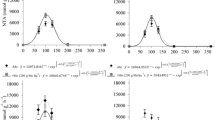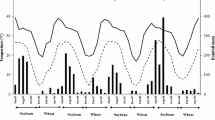Abstract
Aims
In Brazil N fertilization of sugarcane (Saccharum spp.) is low compared to most other countries. 15N-aided studies and the occurrence of many N2-fixing bacteria associated with cane plants suggest significant contributions from biological N2 fixation (BNF). The objective of this study was to evaluate BNF contributions to nine cane varieties under field conditions using N balance and 15N natural abundance techniques.
Methods
The field experiment was planted near Rio de Janeiro in 1989, replanted in 1999 and harvested 13 times until 2004. Soil total N was evaluated at planting and again in 2004. Samples of cane leaves and weeds for the evaluation of 15N natural abundance were taken in 2000, 2003 and 2004.
Results
N accumulation of the commercial cane varieties and a variety of Saccharum spontaneum were persistently high and N balances (60 to 107 kg N ha−1 yr−1) significantly (p < 0.05) positive. The δ15N of leaf samples were lower than any of the weed reference plants and data obtained from a greenhouse study indicated that this was not due to the cane plants tapping into soil of lower 15N abundance at greater depth.
Conclusion
The results indicate that the Brazilian varieties of sugarcane were able to obtain at least 40 kg N ha−1 yr−1 from BNF.




Similar content being viewed by others
References
Arnold SL, Schepers JS (2004) A simple roller-mill grinding procedure for plant and soil samples. Comm Soil Sci Plant Anal 35:537–545
Basanta MV, Dourado-Neto D, Reichardt K, Bacchi OOS, Oliveira JCM, Trivellin PCO, Timm LC, Tominaga TT, Correchel V, Cássaro FAM, Pires LF, de Macedo JR (2003) Management effects on nitrogen recovery in a sugarcane crop grown in Brazil. Geoderma 116:235–248
Biggs IM, Stewart GR, Wilson JR, Critchley C (2002) 15N natural abundance studies in Australian commercial sugarcane. Plant Soil 238:21–30
Boddey RM (1987) Methods for quantification of nitrogen fixation associated with gramineae. CRC Crit Rev Plant Sci 6:209–266
Boddey RM, Polidoro JC, Resende AS, Alves BJR, Urquiaga S (2001) Use of the 15N natural abundance technique for the quantification of the contribution of N2 fixation to sugar cane and other grasses. Aust J Plant Physiol 28:889–895
Boddey RM, Urquiaga S, Alves BJR, Reis VM (2003) Endophytic nitrogen fixation in sugar cane: present knowledge and future applications. Plant Soil 252:139–149
Boddey RM, de B Soares LH, Alves BJR, Urquiaga S (2008) Bio-ethanol production in Brazil. Chapter 13. In: Pimentel D (ed) Biofuels, solar and wind as renewable energy systems: benefits and risks. Springer, New York, pp 321–356
Castro-González R, Martinez-Aguilar L, Ramirez-Trujillo A, Estrada-de los Santos P (2011) High diversity of culturable Burkholderia species associated with sugarcane. Plant Soil. doi:10.1007/s11104-011-0768-0
de Mello WZ, de Almeida MD (2004) Rainwater chemistry at the summit and southern flank of the Itatiaia massif, Southeastern Brazil. Environ Pollut 129:63–68
de Oliveira ALM, Canuto EDL, Urquiaga S, Reis VM, Baldani JI (2006) Yield of micropropagated sugarcane varieties in different soil types following inoculation with diazotrophic bacteria. Plant Soil 284:23–32
de Oliveira ALM, Stoffels M, Schmid M, Reis VM, Baldani JI, Hartmann A (2009) Colonization of sugarcane plantlets by mixed inoculations with diazotrophic bacteria. Eur J Soil Biol 45:106–113
de Souza PA, de Mello WZ, Maldonado J (2006) Composição química da chuva e aporte atmosférico na Ilha Grande, RJ. Quím Nova 29:471–476
Dobereiner J (1961) Nitrogen-fixing bacteria of the genus Beijerinckia Derx in the rhizosphere of sugar cane. Plant Soil 15:211–216
dos Reis FB Jr, Reis VM, Urquiaga S, Dobereiner J (2000) Influence of nitrogen fertilisation on the population of diazotrophic bacteria Herbaspirillum spp. and Acetobacter diazotrophicus in sugarcane (Saccharum spp.). Plant Soil 219:153–159
Ellert BH, Bettany JR (1995) Calculation of organic matter and nutrients stored in soils under contrasting management regimes. Can J Soil Sci 75:529–538
EMBRAPA (1997) Centro Nacional de Pesquisa de Solos. Manual de métodos de análises de solo. Rio de Janeiro
Eskew DL, Eaglesham ARJ, App AA (1981) Heterotrophic 15N2 fixation and distribution of newly fixed nitrogen in a rice-flooded soil system. Plant Physiol 68:48–52
Fischer D, Pfitzner B, Schmid M, Simões-Araújo JL, Reis VM, Pereira W, Ormeño-Orrillo E, Hai B, Hofmann A, Schloter M, Martinez-Romero E, Baldani JI, Hartmann A (2011) Molecular characterisation of the diazotrophic bacterial community in uninoculated and inoculated field-grown sugarcane (Saccharum sp.). Plant Soil (in press doi:10.1007/s11104-011-0812-0)
Giller KE (2001) Nitrogen fixation in tropical cropping systems, 2nd edn. CAB International, Wallingford, p 423
Giller KE, Merckx R (2003) Exploring the boundaries of N2-fixation in cereals and grasses: a hypothetical and experimental framework. Symbiosis 35:3–17
Hoefsloot G, Termorshuizen AJ, Watt DA, Cramer MD (2005) Biological nitrogen fixation is not a major contributor to the nitrogen demand of a commercially grown South African sugarcane cultivar. Plant Soil 277:85–96
IBGE-SIDRA (2011) Instituto Brasileiro de Geografia e Estatística, sistema IBGE de Recuperação Automática. Available on-line at http://www.sidra.ibge.gov.br/bda/prevsaf/default.asp, accessed 8 February, 2011
James EK (2000) Nitrogen fixation in endophytic and associative symbiosis. Field Crops Res 65:197–209
Kempers AJ, Zweers A (1986) Ammonium determination in soil extracts by the salicylate method. Comm Soil Sci Plant Anal 17:715–723
Krusche AV, de Camargo PB, Cerri CEP, Ballester MV, Lara LBLS, Victoria RL, Martinelli LA (2003) Acid rain and nitrogen deposition in a sub-tropical watershed (Piracicaba): ecosystem consequences. Environ Pollut 121:389–399
Ledgard SF, Freney JR, Simpson JR (1984) Variations in natural enrichment of 15N in the profiles of some Australian pasture soils. Aust J Soil Res 22:155–164
Li RP, Macrae IC (1992) Specific identification and enumeration of Acetobacter diazotrophicus in sugarcane. Soil Biol Biochem 24:413–419
Lima E, Boddey RM, Dobereiner J (1987) Quantification of biological nitrogen fixation associated with sugar cane using a 15N aided nitrogen balance. Soil Biol Biochem 19:165–170
MAPA (2007) Balanço Nacional da Cana de Açúcar e Agroenergia. Ministério da Agricultura, Pecuária e Abastecimento, Brasília
Muñoz-Rojos J, Caballero-Mellado J (2003) Population dynamics of Gluconacetobacter diazotrophicus in sugarcane cultivars and its effect on plant growth. Microb Ecol 46:454–464
Muthukumarasamy R, Revathi G, Lakshminarasimhan C (1999) Influence of N fertilisation on the isolation of Acetobacter diazotrophicus and Herbaspirillum spp. from Indian sugarcane varieties. Biol Fertil Soils 29:157–164
Norman RJ, Edberg JC, Stucki JW (1985) Determination of nitrate in soil extracts by dual-wavelength ultraviolet spectrophotometry. Soil Sci Soc Am J 49:1182–1185
Perin L, Martínez-Aguilar L, Castro-González R, Estrada-de los Santos P, Cabellos-Avelar T, Guedes HV, Reis VM, Caballero-Mellado J (2006a) Diazotrophic Burkholderia species associated with field-grown maize and sugarcane. Appl Environ Microbiol 72:3103–3110
Perin L, Martínez-Aguilar L, Paredes-Valdez G, Baldani JI, de Los E, Santos P, Reis VM, Caballero-Mellado J (2006b) Burkholderia silvatlantica sp. nov., a diazotrophic bacterium associated with sugar cane and maize. Int J Syst Evol Microbiol 56:1931–1937
Ramos MG, Villatoro MAA, Urquiaga S, Alves BJR, Boddey RM (2001) Quantification of the contribution of biological nitrogen fixation to tropical green manure crops and the residual benefit to a subsequent maize crop using 15N-isotope techniques. J Biotechnol 91:105–115
Reis VM, Olivares FL, Dobereiner J (1994) Improved methodology for isolation and identification of Acetobacter diazotrophicus and confirmation of its endophytic habitat. World J Microbiol Biotechnol 10:101–104
Resende AS, Xavier RP, de Oliveira OC, Urquiaga S, Alves BJR, Boddey RM (2006) Long-term effects of pre-harvest burning and nitrogen and vinasse applications on yield of sugar cane and soil carbon and nitrogen stocks on a plantation in Pernambuco, N.E. Brazil. Plant Soil 281:339–351
Roper MM, Ladha JK (1995) Biological N-2 fixation by heterotrophic and phototrophic bacteria in association with straw. Plant Soil 174:211–224
Silva-Froufe LG, Boddey RM, Reis VM (2009) Quantification of natural populations of Gluconacetobacter diazotrophicus and Herbaspirillum spp.in sugar cane (Saccharum spp.) using different polyclonal antibodies. Braz J Microbiol 40:866–878
Thaweenut N, Hachisuka Y, Ando S, Yanagisawa S, Yoneyama T (2011) Two seasons’ study on nifH gene expression and nitrogen fixation by diazotrophic endophytes in sugarcane (Saccharum spp. hybrids): expression of nifH genes similar to those of rhizobia. Plant Soil 338:435–449
Urquiaga S, Cruz KHS, Boddey RM (1992) Contribution of nitrogen fixation to sugar cane: nitrogen-15 and nitrogen-balance estimates. Soil Sci Soc Am J 56:105–114
Walsh KB, Brown SM, Harrison R (2006) Can a N2-fixing Gluconacetobacter diazotrophicus association with sugarcane be achieved. Aust J Agric Res 57:235–241
Yoneyama T, Muraoka T, Kim TH, Dacanay EV, Nakanishi Y (1997) The natural 15N abundance of sugarcane and neighbouring plants in Brazil, the Philippines and Miyako (Japan). Plant Soil 189:239–244
Acknowledgements
The authors express their gratitude to Altiberto M. Baêta and Roberto G. de Souza for the total N and 15N abundance analyses, respectively. The author RPX gratefully acknowledges National Research Council (CNPq) for a PhD Research Fellowship and RFM, RBB, NS and JML for undergraduate fellowships. The authors SU, BJRA and RMB gratefully acknowledge “productivity” fellowships from CNPq and from the program Cientista de Nosso Estado of the Rio State Research Foundation (FAPERJ). The work was funded by Embrapa, CNPq, FAPERJ and the Universidade Federal Rural do Rio de Janeiro.
Author information
Authors and Affiliations
Corresponding author
Additional information
Responsible Editor: Euan K. James.
Electronic supplementary material
Below is the link to the electronic supplementary material.
Fig. S1
Root profiles of: A commercial sugarcane variety CB 47-89, B Emilia sonchifolia (lilac tasselflower), and C Commelina erecta (slender day flower), growing in the experimental plots of the long-term sugarcane experiment. (PDF 3219 kb)
Rights and permissions
About this article
Cite this article
Urquiaga, S., Xavier, R.P., de Morais, R.F. et al. Evidence from field nitrogen balance and 15N natural abundance data for the contribution of biological N2 fixation to Brazilian sugarcane varieties. Plant Soil 356, 5–21 (2012). https://doi.org/10.1007/s11104-011-1016-3
Received:
Accepted:
Published:
Issue Date:
DOI: https://doi.org/10.1007/s11104-011-1016-3




